COMPUTER FREE PHOTOGRAPHY
Micro Solutions RoadStor
-- A Prayer Answered
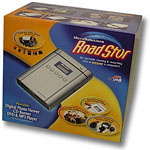 By MIKE PASINI
By MIKE PASINIEditor
The Imaging Resource Digital Photography Newsletter
Digital imaging's dirty little secret is that it's easier to travel with a film camera than a digicam.
If you run out of film, you're only a drugstore away from a fresh supply. If you fill up your storage card, though, you've got problems. To reuse the card, you've got to copy the images off it.
| C O N T E N T S |
There have been imperfect solutions:
1) Pack a laptop. Copy the images to the hard drive. Burn a couple of CDs. This is our preferred solution. But, except for business users, this solution adds a piece of luggage.
2) Pack extra cards. Fine but finite. And easily misplaced as you move from hotel to guest room. Worse, no backup.
3) Pack a small hard-drive/reader combo. Call it a wallet or vault or whatever, it won't make backups either -- and costs nearly as much as a laptop.
What we really wanted all along was something 1) smaller than a laptop, 2) convenient as extra cards, 3) designed to make backups and 4) inexpensive.
But not just for travel. We've been touting the utility of 4x6 and larger printers that don't need a computer to deliver beautiful photo prints. But the problem is that sooner or later you need to copy the images off that card to a CD.
We've been playing with Micro Solutions RoadStor for a few days now and this little box has answered our prayers. Whether you want hassle-free travel with your digicam or just want to store its images after printing them without wrestling with a computer, it may answer yours too.
THE ROADSTOR | Back to Contents
The RoadStor is a well-connected CD-writer/DVD-player (CD-RW/DVD-ROM drive) with a card reader. At 1.4x5.4x6.875-inches and 26 oz. (both with battery), it imposes no more of a burden on a traveler than a hardback book or a couple of DVDs.
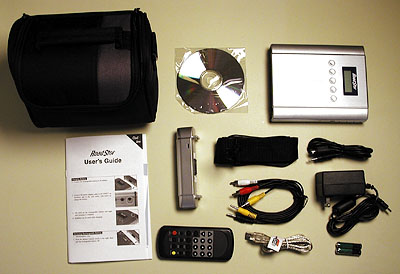 |
(Top row) Carrying case, blank CDs, the RoadStor; (row two) manual and software, battery, strap, S-Video cable; (row three) video cable, power adapter; (bottom row) remote, USB cable and, yes, batteries included. |
The card reader and combo drive are both accessible from the rear of the unit. The slim reader sits on top of the combo drive with two slots (only one active at a time) to read MultiMedia Card, Secure Digital, Memory Stick, SmartMedia, CompactFlash Types I/II and IBM Microdrive formats. xD-Picture cards are not supported. A green LED indicates reader activity. An orange LED indicates drive activity.
 |
(Left) MMC, SD, Memory Stick and SmartMedia slot; (right) Compact Flash, Microdrive slot. The CD-RW/DVD-ROM drive runs along the bottom. |
The combo drive is an Hl-dt-st RW/DVD GCC-4241N (4x-write/24x-read CD), according to Roxio Toast's Recorder Info option, with firmware revision 0H22/MMC-3 with a 2-MB cache and buffer underrun prevention.
The custom lithium-ion battery attaches to the other end of the RoadStor and delivers about two hours of use after a four-hour charge. A release button on the bottom of the unit unlatches the battery. You can also run the device from the included adapter.
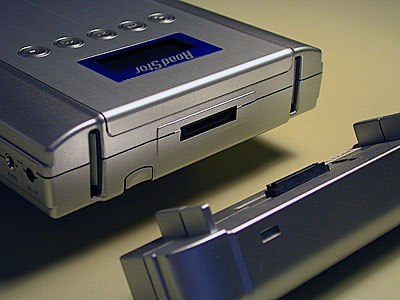 |
| The Battery A release button on the bottom of the unit releases the battery. |
Connectors include USB 2.0 (to function as another device on your computer), Video Out (for slide shows and DVD playback), S-Video Out (to show off) and Audio Out (for music CD and DVD playback). There's also an NTSC/PAL video format switch, particularly handy for international travel since playback is through a television.
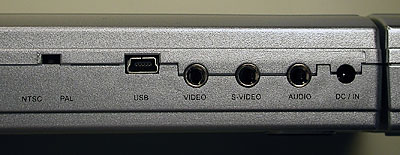 |
| Ports NTSC/PAL switch, USB, Video, S-Video, Audio and DC in. |
This is, by the way, a high-speed USB 2.0 device, not merely USB 2.0 compatible. It did function on our USB 1.x ports, though.
Five buttons on top control the player with feedback from a black and white LCD. The firmware is not user-upgradeable. A remote control is also included, along with cables for USB, S-Video and Composite Video & Audio.
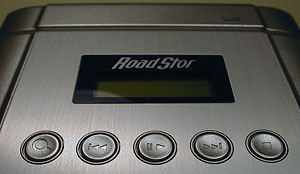 |
We needed only the first one (to copy images to a CD). Playback was handled with the remote control. |
CD burning software and DVD player software for Windows is included. A device driver for Windows 98 is also included.
Macintosh support relies on OS X's built-in burning and playback software. But until recently Mac hardware supported only slower USB 1.x transfers (preferring FireWire for this sort of stuff). You can read your CDs via the RoadStor and even play DVDs (though not smoothly) but you'll need third-party software to write to CDs via the RoadStor.
Documentation includes a thin but thorough User's Guide, Software License Agreement, registration card, Speedy CD Software manual and a couple of blank CDs. It's all packaged in a nice carrying case (with a one-year warranty) for $249.
UNIQUE? | Back to Contents
Shortly after the RoadStor was introduced, Alera Technologies came out with its $249 Digital Photo Copy Cruiser, a 36x CD writer with a USB 2.0 port and a reader that handles CompactFlash Type I and II, Secure Digital, MultiMedia Card, SmartMedia, Memory Stick, Memory Stick Pro and Microdrive formats.
We've asked for an Alera unit to review, but at first glance it lacks RoadStor's DVD player and television signal output for reviewing your images.
Preceding both earlier this year was the $300 Nixvue Vizor with a 12x/48x CD-RW drive with a 2-MB buffer. Weighing 22 oz., its reader can handle Memory Stick, Compact Flash (Type I and II), Secure Digital and MMC formats. An optional adapter is available for SmartMedia and XD cards. It includes a remote control, video out (NTSC or PAL) plus an optional LCD monitor for viewing images. Plus, it's firmware can be updated.
Unlike the RoadStor, it can display RAW image formats form Nikon, Canon, FujiFilm and Minolta. But it can't play DVDs.
Finally, we'll note the Apacer Disc Steno CP200, a USB 2.0, 24x CD writer (2-MB buffer with underrun prevention) with both a a 5-in-1 SD/MMC/MS/MS PRO/SM and a CompactFlash reader. A remote control is provided and the Web site does mention video playback but we don't see a video port in the specs. Apacer does tout its "CD spanning" technology to handle very high capacity cards.
BACKUP OPERATION | Back to Contents
With either a charged battery or the adapter attached, you power on the unit with the On/Off Switch.
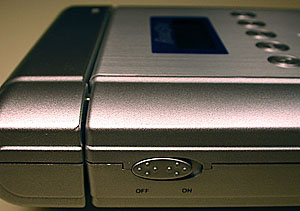 |
| On/Off Switch The battery is attached to the left. |
To copy images (or any other files) from a storage card to a CD, open the CD tray by pressing the Eject button on its front panel. Insert a writable CD-R or CD-RW (either a blank or one that can still be written to). Then close the tray.
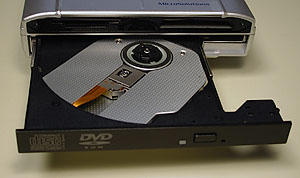 |
| The Drawer |
It takes a few seconds for the RoadStor to load the CD. When it's done, you can pop in your storage card.
Press the Backup button on the RoadStor or its remote control to enter backup mode. Press it again to confirm the operation and begin copying images from the card to the CD.
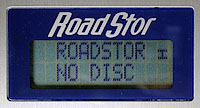 |
| The LCD |
We were concerned about what kind of feedback that little LCD would give me on the backup process, which isn't simple when you're writing to a CD. I found the RoadStor kept me well informed, so I wasn't tempted to pop the CD out before it the session had been wrapped up.
The top line of the little LCD gives you a status message while the bottom line reports progress in percent. If you watch the process on a television, you also get a progress bar. DISC LOADING, DISC BURNING, BURNING CD are the three status messages. When DISC BURNING hits 99%, BURNING CD starts. When the process is over, the CD is automatically ejected.
We were able to copy whatever we put on a card (even images that we copied from a computer). Text, RAW files, movies, it didn't matter.
RoadStor itself does not verify the copies. The company told us, "Verification using Windows or Mac tools can be performed after the backup is complete, if desired. Microsoft's FC (File Compare) would perform such a function."
As long as there is space available on the CD, you can repeat the procedure to add images to the CD. Each session is stored in a new folder, named RDST0001, RDST0002, etc. The actual images are buried a bit deeper, usually in the DCIM folder.
The 4x-write/24x-read CD writer includes buffer underrun protection to avoid burning toasters instead of CDs.
What happens if there's more on the card than fits on the disc? We filled a CD nearly to the brim and then tried to copy a full card to it. "NEW DISC IN," the RoadStor prompted us. When we put a new disc in, the RoadStor backed up the card.
And what about 1-GB cards? We didn't have one handy, so we asked. "This is an issue that we're currently researching and hope to have support for soon," the company told us. "We plan to keep RoadStor compatible with 1-GB and larger memory cards and will provide information on www.micro-solutions.com when such support becomes available."
PLAYBACK OPERATION | Back to Contents
If you want to view your images from the card or a CD, or watch a DVD, make your connections before powering on the device. Video cables are color coded to make connection simple (yellow is video, white and red audio). Use your television's Input switch to display the signal from the External connection.
With both the television and the RoadStor powered on, and the television displaying the External signal, you see the RoadStor sign-on screen (just as you would your DVD player's sign-on screen).
Pop in a DVD and use the remote control to navigate the Main Menu and Play the movie. Once you learn which buttons on the remote do what, it's just like having a portable DVD player.
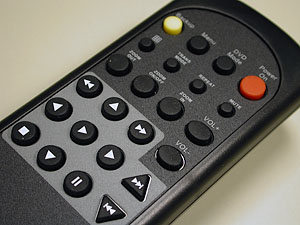 |
| The Remote Control |
To see the pictures on your storage card, pop a card into the right slot of the card reader. RoadStor displays its Card Menu, which lets you navigate the directory structure until you find the session you want to see. You can even interrupt DVD playback by inserting a card.
To see the pictures on a CD, drop in the CD. RoadStor displays its Disc Menu, which functions exactly like the Card Menu.
You have to select the first image in a directory to begin the slideshow. Eleven different transitions can be activated by pressing the Transitions button on the remote. You can also set Transitions to None or Random. You can rotate and zoom images, or view them in a 3x3 thumbnail format.
The device also supports VCDs, Enhanced CDs, CD-Text, CD-I and Multi-session Photo CDs. In fact, it even played a VCR slide show our cheapo brother-in-law burned with the demo version of some slide show program.
While you can copy anything on the card to a CD, not everything can be displayed by the RoadStor. MPEG-1 and MPEG-2 videos are decoded and played back using RoadStor. But Macintosh MOV files are not decoded or listed, nor are Microsoft .AVI files. RAW images are not decoded or listed either.
COMPUTER OPERATION | Back to Contents
If you connect the powered-on device to your computer via USB, you'll have access to a card port and the CD-writer/DVD-player. You can then copy images from a mounted CD to a mounted card, burn images on your computer to a CD, play DVDs on your computer (if your computer has a USB 2.0 port).
We connected the RoadStor to a PowerBook G4 and were able to read cards and CDs and even play a DVD (a bit choppy in parts, but not viewable). We weren't able to burn CDs in OS X, though. We suspect OS X doesn't want to write using a USB 1.x port. Roxio Toast, however, did recognize the drive for burning.
SIMPLE | Back to Contents
That's really all there is to it. Turn it on, drop in a CD, slide in a card and push the Backup button twice. You've copied your images. Do it again and you've backed them up. Simple. Fast. Elegant.
But wait. Say you're at a wedding. Plan to be the last to go. Ask everyone with a digicam if you can copy their card before they leave. You'll have a complete set of every digital image shot -- and you can even sort them by time (assuming everyone set their camera's clock correctly) for a unique, second-by-second instant replay from multiple angles. Pretty wild!
In fact, let us be the first to propose that the time-honored ministerial prohibition against flash pictures during the ceremony be rephrased:
"The wedding party asks that you refrain from flash photography during the ceremony and instead confirm your camera's date and time settings so they may be accurately included in Mr. Chimichanga's compilation CD, to which you are invited to contribute at the end of the festivities."
There goes the disposable camera favor, too.
BUTTONITIS & BLATTERIES | Back to Contents
We're a firm believer in using the least buttons. The five on the RoadStor are pretty minimal. Copy, Back, Play/Pause, Forward and Stop. The remote control was, initially, maddening. Play and Forward have the same icon, which can drive you mad when you're navigating a CD and want to Play a folder. Instead, you Forward the first image. And there's no Menu button for DVDs (try the Stop button) but you can Fast Forward from one chapter to another. It isn't intuitive (like a DVD remote, in fact) but you figure it out.
Exhausting a battery in two hours is a bit more of an issue for DVD playback than card backup to CD. You can backup a lot of cards in two hours. One battery should be sufficient to copy images from any event. But it's only enough to play one movie. And it won't play too many audio CDs (maybe one day's bus commute to school). So don't forget to bring the adapter along. With a four-hour recharge, you won't have time to recover from a dead battery.
A spare battery (BAT-001 for $39.99) is probably not a bad idea. Micro Solutions also sells replacements for the remote ($9.99), carrying case ($24.99) and power adapter ($24.99).
COMPUTER-FREE WORKFLOW | Back to Contents
As a travel companion for your digicam, the RoadStor is an obvious boon. But, combined with the right printer, it promises a completely computer-free workflow.
We find that second option pretty exciting. We suspect there are plenty of snapshooters out there who would love to have the "free film" of digital imaging. But they just don't want to use a computer to get it.
They really don't have to any more.
The RoadStor solves the long-term storage and archiving problem. With a RoadStor, images captured to a supported storage card can be copied to a couple of CDs for safe storage and the card can be erased in the camera for reuse.
Before erasing the card, though, the images can be printed (and even edited) on a printer with a card reader and editing firmware. The Hi-Ti 630PS and 640PS photo printers can print affordable 4x6 dye subs automatically in less time than it takes to go to the drugstore. And inkjet prints as large as borderless 8.5x11s can be printed on the Hewlett-Packard 7960. All those printers include card readers and LCDs to edit, select and print images just as if you were at your own drugstore kiosk.
The only glitch in such a system is reprinting images stored on CD. You would need a computer to copy them to a card.
QUIBBLE METER | Back to Contents
We hooked up our Quibble Meter to the RoadStor and got a few faint readings. The Quibble Meter is very sensitive to minor annoyances, the stuff the typical review glosses right over. So take the readings with a grain of salt.
The power adapter plug doesn't completely seat in the outlet. The first model Micro Solutions sent actually didn't even hold the plug securely. A wiggle and contact was broken. A second unit did better. But we suspect the connector in the RoadStor itself isn't quite the match it should be. There's an eighth inch gap between the rubberized plug and the unit itself.
On both units the CD drawer seemed to catch on the frame when we closed it. One thing that did help was pushing from the ends of the drawer, rather than the middle. Two thumbs are better than one.
Also on that first unit, the small plastic LCD frame didn't adhere to the LCD when we removed the protective platic from it. We were able to press it back on, though. Micro Solutions is aware of the problem and told us future productions runs would correct it.
These quibbles didn't affect the device's ability to function. But we invented the Quibble Meter for people like us who are uncomfortable with fit and finish issues.
CONCLUSION | Back to Contents
Were we given to adjectives, we'd call the RoadStor indispensable. Were we into awards, it would be the Imaging Resource Peripheral of the Year. Were we thieves, we'd steal one. If we were a retailer, we'd bundle it with every digicam we sold. Were we wealthy, we'd give one to each subscriber.
But let's not fantasize any longer. Our prayers for a simple, portable device to archive and duplicate our images -- whether we're on the road or just want to enjoy digital photography without a computer -- have been answered. Amen.